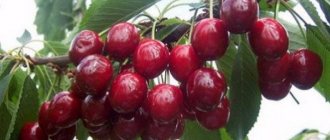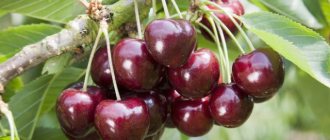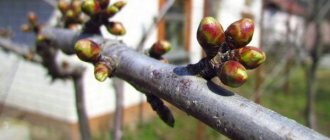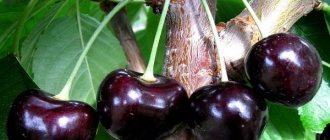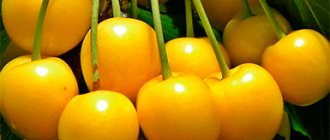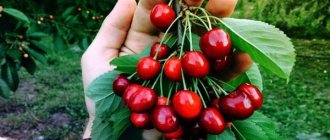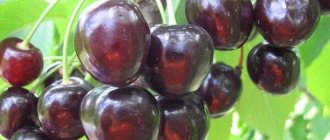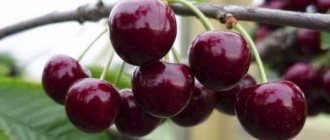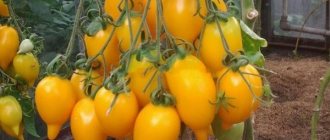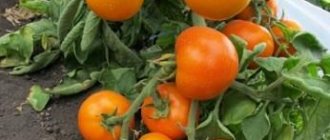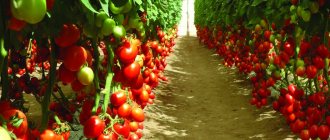Diseases and pests
Damage to fruit trees by diseases and pests can be avoided if preventive maintenance, tree inspection and sanitary cleaning are carried out promptly and regularly.
These activities are simple and do not require special knowledge or significant labor costs:
- removal of fallen leaves and carrion from the garden;
- whitewashing the trunk and skeletal branches with lime solutions;
- sanitary and thinning pruning to combat harmful lesions and improve lighting and ventilation of the crown;
- removal of young shoots and weeds in tree trunk circles;
- autumn digging of the soil with turning over layers of earth to kill pests and pathogens from frost;
- spraying the tree against pests with pesticides “DNOC”, “Nitrafen”, Bordeaux mixtures, copper sulfate solution (5%);
- installing hunting belts on a trunk at a height of 30–40 cm and covering the tree trunk circle with agrofibre.
Important! Protect your hands, face and eyes when working with chemicals. Follow the instructions strictly and do not exceed the dosage
After treatment, you should take a shower and wash your face and hands with soap.
Black Leningrad cherry is resistant to pests, but unfavorable conditions, insufficient care and infection from neighboring plants can lead to damage. The need for protective measures is determined by the threshold of harmfulness, based on a comparison of the observed number of pests with the threshold number.
Control measures in case of mass appearance of pests:
- Cherry fly and leaf roller - trees are sprayed with insecticides "Arrivo", "Fury", "Confidor", "Decis", "Fufanon", "Iskra", "Aktellik". 2 treatments are required with an interval of 10 days. You can treat affected trees with repellent infusions of tobacco, pine needles, wormwood, garlic, or hang traps with sweet syrups.
- Cherry pipe roller - treatment with Aktara, organophosphorus pesticides: metaphos, karbofos, benzophosphate. Digging up the soil and mechanically shaking off the branches will help reduce the number and destroy the beetles.
- Cherry aphids and sawflies - spring treatment on dormant buds with insecto-acaricidal preparation "30B, 76% ke", "Aktelik", "Karbofos", "Inta-Vir". Infusions of dandelion leaves, onion feathers, elderberry inflorescence or tobacco. When the buds open - “Confidor”, “Aktofit”.
- Birds - when fruits ripen, rustling ribbons or shiny foil are hung on trees. You can cover the crowns with nets or use special ultrasonic repellent devices.
- Fungal infections (moniliosis, chlorosis, coccomycosis) - remove problematic branches to healthy wood and burn them, and treat the tree three times with an interval of 1 week with antifungal drugs “Chorus”, “Abiga-pik”, “Hom”, “Strobi”.
Advantages and disadvantages
pros
Excellent taste qualities of the products, which is why the variety is highly popular all over the world. Excellent transportability and product safety. Quite high yield when grown correctly. Presence of resistance to major diseases. Low overhead part, which allows you to collect products in comfortable conditions. Stable fruiting.
Minuses
The variety is unsuitable for cold climates, as spring frosts will destroy the flowers. Does not tolerate waterlogged soil and poor lighting. Needs pollinators, without which there will be no ovaries. To obtain a large harvest, significant expenditures of resources are required.
We have before us a variety with excellent taste, which allows us to use the products both for fresh sale and for personal use or processing. It is worth noting that the efforts of the breeders were aimed at creating a variety that will produce incredibly tasty berries in the middle of summer, when they are in demand.
Positive qualities include the following characteristics of culture:
- abundant fruiting;
- excellent taste of berries;
- compact size of the tree;
- good transportability;
- resistance to diseases and pests.
pros
- Excellent taste qualities of the products, which is why the variety is highly popular all over the world.
- Excellent transportability and product safety.
- Quite high yield when grown correctly.
- Presence of resistance to major diseases.
- Low overhead part, which allows you to collect products in comfortable conditions.
- Stable fruiting.
Minuses
- The variety is unsuitable for cold climates, as spring frosts will destroy the flowers.
- Does not tolerate waterlogged soil and poor lighting.
- Needs pollinators, without which there will be no ovaries.
- To obtain a large harvest, significant expenditures of resources are required.
Tags: cultivation, golden, Rossoshansky, cherry About the author: admin4ik
Harvest and storage
Cherry fruits reach ripeness, depending on the growing region, in the first weeks of June or July. It is recommended to pick the berries on a dry, warm day, since fruits picked during periods of high humidity do not lend themselves well to long-term storage.
As a rule, the berries are picked along with the stalks and stored in glass or plastic containers. It is necessary to pick cherries with extreme caution, since broken bouquet branches are not restored, which leads to a decrease in the amount of harvest next season. The picked berries are carefully sorted, rotten, damaged, bursting fruits are discarded.
For long-term preservation, only dense, large, not overripe cherries without visible damage are left. Store the fruits in the refrigerator or in a room with stable temperatures of –1…+1°C and a relative humidity of 90–95%. Under such conditions, the berries can be stored without loss of taste and aesthetic qualities for two weeks.
Fruits can also be frozen. Rossoshanskaya Zolotaya cherry is one of the most successful varieties for cultivation in warm climates. It does not require extreme growing conditions, is easy to care for and can produce extremely tasty, juicy and sweet berries in the middle of the summer season, exactly when they are most in demand.
How to plant Rossoshanskaya Golden cherries
Rossoshanskaya Zolotaya is undemanding when it comes to feeding and fertilizers used. The soil should be provided with nutrients before planting, and then the level of microelements should be maintained at the same level annually.
How to choose a seedling
It is better to plant two-year-old seedlings of this variety, which will begin to bear fruit in three years. The root collar is buried 10–15 cm. Young plants are watered abundantly and the soil surface is mulched.
Planting dates and scheme
The optimal time for planting the Rossoshanskaya variety in the fall is in October or late September. In the spring, you can also plant a cherry plantation after the soil has thawed, before the buds hatch.
The diagram above shows the distance at which young animals are planted. If you make a gap less than 6 meters, this will negatively affect the yield, because cherries love light. Symbols for berry crops help you choose a place for them on the site next to the cherry.
Pit preparation
A hole with a seedling of the Rossoshanskaya variety is framed with an earthen rampart so that during watering or rain, water is retained in the trunk circle of young cherries. The hole is made with a diameter of 60 cm and a depth of 70. The width can be reduced according to the size of the root system. The grafting site is not lowered into the ground, so as not to expose it to putrefactive processes.
Advice! If planting is planned in the spring, then the hole is prepared in the fall so that the soil is saturated with the applied fertilizers. The hole is prepared in the spring 2 weeks before work.
Basic care recommendations
The first step is to provide the plant with high-quality watering. It is not shared often. The optimal interval for adding water to the soil is 20–25 days. For this, warm water should be used, since the plant absorbs it better. There should be 20 liters of liquid per bush. After each watering, a week later, you need to loosen the top layer of soil and remove all weeds.
The first fertilizing is applied a year and a half after planting. First, the plant needs to be fertilized with potassium nitrate (30 g per 10 liters of water) to ensure the stability of the ovaries. In autumn you need to apply superphosphate fertilizers (70 g of superphosphate per 10 liters of water). At least 20 liters of such solutions must be poured under each plant.
The plant does not need pruning. The only exceptions are when the tree shows signs of disease or dryness.
Description of fruits
We always appreciate cherries for their tasty and fairly large berries, which we will talk about later.
The very name of the variety suggests that the cherry berries are painted in a bright “golden” color. However, if the tree was planted in an open place and the fruits are well illuminated by the sun, then a pinkish tint is acceptable.
The cherries are large, weighing about 7 g. The pulp is quite dense and fleshy, which improves the transportability of the product. The shape of the fruit is heart-shaped, slightly flattened on the sides.
The taste is also excellent. The berry has a honey taste with barely noticeable sourness. The cherries are so tasty that they received the maximum score for their taste.
Cherry "Rossoshanskaya gold" needs pollinators, since the variety is self-sterile. That is, if you do not have other cherry trees in your garden, then buying a seedling of this variety is pointless, since you will not get a harvest.
Two varieties of cherry are perfect for pollination - “Miracle Cherry” and “Nochka”. Or another cherry variety “Ovstuzhenka”.
We remind you once again that the site must have the above-mentioned pollinating trees; the presence of insects will not improve the situation in any way if “Rossoshanskaya Zolotaya” grows in “splendid isolation.”
Winter hardiness
The manufacturer states that cherries have good winter hardiness, but you should pay attention to early flowering. If you experience frosts in April, the flowering plant will simply freeze and not produce a harvest. Based on this, we can conclude that average winter hardiness will be observed only in the southern part of the Central Black Earth Region. In more southern regions, the variety feels great, since winter frosts cannot harm it, and during flowering, in this region, night frosts are not observed.
Landing Features
Transferring the tree to open ground should be carried out according to the deadlines, to a suitable place
It is important to respect the proximity of cherries; not all plants are suitable for this
Recommended timing
The tree tolerates low temperatures well, so it is better to plant it for the winter. The favorable period for this is the end of September - beginning of October. Planting is also carried out in spring. To do this, you need to select a seedling before bud formation begins.
It is important that all processes of the vegetative period occur after planting, this will strengthen the plant
Choosing a suitable location
Choose a place for cherries that is well-lit, with minimal risk of flooding the tree, and without drafts. The tree is unpretentious to soil fertility, the main thing is that it is light and well aerated. There should be no other trees closer than 6 meters near the plant. This reduces cherry yields.
Suitable and prohibited neighbors of cherries
Suitable for proximity to cherries are:
- pear;
- apricot;
- other types of cherries;
- peach;
- gooseberry;
- raspberries;
- currant;
- grape.
The tree does not grow well next to plum, apple and cherry trees; you should not plant them next to each other.
Seedling preparation
Seedlings are bought at garden markets. Most often they can be found in the autumn. It is better to choose trees without grafting, with good dense branches. There should be no damage, cracks or scratches on the shoots
It is important to pay attention to the roots so that they do not rot. In the fall they buy seedlings with fallen leaves, and in the spring with not yet swollen buds
Important! One-year-old trees take root better than two- and three-year-old trees
Disembarkation algorithm
Pre-prepare the soil. If it is clayey and heavy, it is mixed with sand. In the acidic environment of the earth, the plant does not take root well, so dolomite flour is added to the soil. Planting is carried out as follows:
- Dig a hole 60 cm deep and 80 cm in diameter.
- A wooden stake is driven into it, which in the future is tied to the seedling to protect it from strong winds.
- Part of the excavated soil is mixed with humus, potassium mineral fertilizers and superphosphate are added.
- The roots of the seedling are straightened, damaged areas are cut off.
- Placed in a hole.
- Sprinkle the top with soil mixed with fertilizers.
- Sprinkle with soil in layers, after which each of them is compacted so that there is no space left with air.
- Pour 10 liters of water into the hole.
Important! The roots are sprinkled with half of the soil dug out of the hole, so that there is a depression around the trunk.
Features of cultivation and subtleties of care
Cherry Yaroslavna is quite easy to care for. Like any tree, it needs watering, fertilizing and pruning. In general, all these events do not have any varietal characteristics, so we will not dwell on them. Let's talk about pruning in more detail. Since the tree of this variety has great growth power, the suitable form for the crown is sparsely tiered. Rules for this formation:
- The first step was taken during planting - the central conductor was trimmed.
- In early spring of the next year after planting, the first tier of the tree is formed. To do this: 2-3 good shoots are selected on the trunk (they will become skeletal branches) that meet the following conditions:
- The lower shoot is located at a distance of 30–40 cm from the ground.
- Shoots grow in different directions.
- The distance between them is 10–15 cm.
- All buds below the first selected shoot are blinded.
- Branches, except those chosen as skeletal ones, are cut into a ring.
- The remaining shoots are shortened by 30–40%.
- The central conductor is cut at a height of 10–15 cm above the base of the upper branch.
After 1–2 years (also in early spring), the second tier of skeletal branches is formed in a similar way. After another 1–2 years, the third tier is formed - usually it consists of one branch. The central conductor is cut above the base of the upper branch.
Yaroslavna cherries are pruned so as to create a sparsely tiered crown shape.
All other pruning (sanitary, thinning, rejuvenation) is carried out according to the usual rules.
Recent Entries
English varieties of roses with strong resistance to powdery mildew and black spot From Gagarin to Jackie Chan: Varieties of garden flowers named after famous people 7 varieties of unpretentious barberry that can be planted in any soil
Description of culture
The common name unites trees that are dissimilar in appearance of fruits and varietal characteristics.
Rossoshanskaya large
The description of the large Rossoshanskaya cherry variety should start with the fruits. Its berries are really large, reaching a mass of 6.7 g. Their shape is round - oval, slightly flattened on the sides, the color is very beautiful, rich dark burgundy.
Important! The berries are characterized by good transportability and are suitable for transportation over long distances. The crown of the large Rossoshanskaya tree has medium density, a pyramidal shape with vertically growing branches. This variety is excellent for growing in small garden plots, since the tree is compact and short in stature - no more than 4 m
During flowering, the large Rossoshanskaya cherry is very decorative due to its large snow-white flowers
This variety is excellent for growing in small garden plots, since the tree is compact and short in stature - no more than 4 m. During flowering, large Rossoshanskaya cherry is very decorative due to its large snow-white flowers
The crown of the large Rossoshanskaya tree has medium density, a pyramidal shape with vertically growing branches. This variety is excellent for growing in small garden plots, since the tree is compact and short in height - no more than 4 m. During flowering, the large Rossoshanskaya cherry is very decorative due to its large snow-white flowers.
The variety is intended for cultivation in the North Caucasus region.
Rossoshanskaya black
Not every variety can boast of such dark berries as black Rossoshanskaya cherries. They really are almost black with a barely noticeable burgundy tint. Large round berries have a very small seed and dense pulp. If they are fully ripe, it is easy to tear them off from the stalk - the tearing is dry, the stone also comes off easily.
Photo of black Rossoshanskaya cherry:
According to the description of the Rossoshanskaya black cherry variety, the low tree does not grow higher than 3 m. It is easy to care for and the berries are easy to pick. The neat crown has the shape of a pyramid. The foliage is strong, especially on young shoots.
Important! The pulp of the berries is quite dense, due to which they have good transportability. Reviews about the black Rossoshanskaya cherry say that it produces an excellent harvest in the North Caucasus, Central Black Earth and Lower Volga regions, where it is zoned. There it is grown not only in home gardens, but also industrially.
There it is grown not only in home gardens, but also industrially.
Reviews about the black Rossoshanskaya cherry say that it produces an excellent harvest in the North Caucasus, Central Black Earth and Lower Volga regions, where it is zoned. There it is grown not only in home gardens, but also industrially.
Rossoshanskaya gold
Let’s begin the description of the Rossoshanskaya Golden cherry variety with the fact that it fully justifies its name. The sunny, fleshy berries weigh up to 7 g. The description of the Golden cherry says that a tree illuminated by the sun all day produces berries with a pinkish tint. Photo of golden cherries.
The fruits are heart-shaped, slightly flattened on the sides. This variety is one of the ten most delicious and sought after. Reviews of the Golden Rossoshanskaya cherry are usually enthusiastic, and for good reason: a tasting score of 5 points is an excellent characteristic of the berries. The barely noticeable sourness and honey tint in the taste make it unlike berries of other varieties; this is always noted in the description of the Golden cherry variety. Among the cherries there are not many trees with yellow fruits, but even against their background it compares favorably, which is confirmed by the description of the Rossoshanskaya yellow cherry variety. The fruits are well transported, since the pulp has a dense structure and a dry separation from the stalk.
The description of the Rossoshanskaya Golden variety will be incomplete without mentioning the dimensions of the tree. For small gardens, it is very convenient that it has a low growth force - no more than 3 m. Like other varieties in this series, the crown is pyramidal, moderately leafy.
Photo of golden cherries:
Video about the Rossoshanskaya golden cherry:
Subsequent care of the crop
Cherry is sensitive to the presence of moisture in the soil. It is optimal to organize drip irrigation for it and mulch the tree trunk circle with mowed grass.
The tree needs to be fed with nitrogen fertilizers in the spring. In early July they feed with complex fertilizers, and in September with phosphorus and potassium fertilizers.
Advice! In order for cherries to be less exposed to frost in winter, they need to be fertilized with sodium-containing minerals.
This culture grows very quickly, sometimes the annual growth can be up to one meter, so constant formation is necessary.
To reduce the height of a mature tree, the central conductor is removed at the beginning of fruiting. After thinning the crown, the cherry tree should have a sparse tiered appearance, with three skeletal branches located in each of the tiers. There should be 50 cm from one tier to another. Annual growths are cut off especially carefully, since flower buds are located at their base.
Advice! If there is a desire to grow Rossoshanskaya golden cherries in the middle zone and even further north, it can be formed in a bush or slate form.
If Rossoshanskaya golden cherries are grown in areas with cold winters, in the first 3-4 years of life the tree is carefully protected from frost, wrapped in spruce branches and non-woven covering material. For the winter, the root zone must be mulched with a layer of humus. In autumn, trees are whitewashed with lime mortar to which a fungicide has been added. The young stem is protected from rodents using a special mesh. Trees that received moisture-recharging irrigation in the fall will withstand winter frosts much better.
Diseases and pests, methods of control and prevention
Golden Rossoshanskaya cherries are loved not only by people, but also by pests. With average resistance to fungal diseases, it requires mandatory preventive treatments against them. The main diseases of the Golden Rossoshanskaya cherry and measures to combat them can be summarized in a table.
| Name | Manifestation | How to fight |
| Brown and fruit rot | Brown spots on leaves and berries | Copper fungicides |
| Clusterosporiasis | Spots and then holes on the leaves, which eventually fall off. The fruits dry out. | Preventively treated with copper-containing fungicides. Treat with Nitrafen, excluding the flowering period and 3 weeks before harvest |
| Coccomycosis | Pink spots on the front side of the sheet and a pink coating on its underside | Triple treatment with Hom, Topaz: on a green cone, after flowering and harvesting |
| Moniliosis | Shoots and leaves dry out, berries rot | Treatment with Nitrafen and Oleocuprite before and after flowering |
| Anthracnose | Pink dots appear on the berries. They dry up | Three-time treatment with Polyram, the timing is the same as for coccomycosis |
Cherry moniliosis:
Of the pests on Rossoshanskaya golden cherries, you can most often notice various sawflies, from which Iskra-M and Piriton help.
Slimy sawfly:
Cherry and pear pipe rollers roll the leaves into a tube, then they dry out. They are fought with Carbophosphate.
For cherry weevil, which damages all green parts of the plant, use Karbofos or Intavir.
It also helps against cherry aphids. Cherry shoot moth and cherry fly are destroyed with the drug Iskra.
Review: Cherry Agrofirm Search “Rossoshanskaya large late” – The late cherry turned out to be early.
To replace old cherries in the fall, at a sale due to the end of the season, I bought two large Rossoshanskaya cherries. The discount was 30%. A discount always makes me happy. If trade is the engine of progress, then discount is the engine of trade. I didn't expect a quick harvest.
I have experience growing cherries since 1989. I bought the first two cherries (early and late) at the market at the Timiryazev Academy. At that time, cherries were a novelty in the Moscow region. Both cherries froze the next year, but I managed to graft branches from them onto ordinary Vladimirskaya cherries and finally, in the eighth year, the first fruits appeared. Now that cherry tree, two old tall trees, regularly produces a sea of cherries and is preparing for extinction.
The photo shows an old cherry tree over 25 years old (Istrinsky district, Moscow region). Two more old cherries have already died from age.
Already this year, the cherry trees of the Rossoshanskaya large variety planted in the fall bloomed and produced their first harvest. Both cherries, contrary to the variety and characteristics on the label, turned out to be early and ripened earlier than the early cherries and early sweet cherries growing on our site. Apparently there was a mismatch, but I'm not offended.
These are the labels the seedlings were provided with:
I planted one cherry tree in the shade of a farm building. The berries on it are not yet ripe. Nevertheless, a week later, during the next visit to the dacha, only seeds remained from the berries. Apparently the cherries were ripe and the birds appreciated the cherries before their owners.
The cherries on our site bear fruit regularly and abundantly to the delight of the whole family, but there is one problem: birds and wasps love cherries. The sparrows, as in the joke about the Ukrainian who was biting the apples, peck the cherries, and the wasps eat them up.
Even a woodpecker flew to the cherry tree, looked around for a long time, like I wasn’t after the cherry, and then carefully pulled the berry, stuck it in a sharp joint of the branches and pecked it out completely, then the second berry and flew back regularly after two hours, but ate only two berries without spoiling the rest.
In the fall, in addition to cherries, I bought seedlings of apple and pear trees from Agrofirm Poisk Vereya. All seedlings with a good root system, sold in pots, overwintered and are in excellent condition.
Despite the fact that apparently there has been a misgrading and the cherries do not correspond to the large Rossoshanskaya variety, I definitely recommend buying cherry seedlings and other seedlings of fruit plants from Agrofirm Poisk Vereya.
Don’t be afraid, plant cherries not only in the southern regions of the Russian Federation, they grow well where cherries grow. Then this sweet berry will be enough for both us and the birds.
Reviews
Oksana, 45 years old, Moscow: “I have long wanted to try growing the Rossoshanskaya Golden Cherry variety. This year I bought a seedling with a pollinator. My soil is clayey, so I mixed it with sand. Planting was carried out in the spring. By mid-summer the first buds appeared. The pruning was carried out up to the third tier. The tree grows quite quickly, by the end of the season the height has increased by almost a meter.”
Alexander, 59 years old, Chekhov: “I planted Rossoshan golden cherries 8 years ago. I bought it at the market. I planted it for the winter and it took root well. It produces a lot of fruits, they are sweet, juicy and large. Planted a tree next to a pollinator. In the fourth year of life it began to bear fruit. Every spring I treat for pests, and I haven’t been sick with anything yet. We have good dry soils, we don’t worry about watering. Once I didn’t irrigate for a month, but it still gave a good harvest.”
Appearance of Rossoshanskaya Black cherry
Let us consider separately the appearance of the tree and the fruits themselves.
Tree
When mature, the tree does not exceed four meters, which is an absolute advantage of this variety. The crown has a characteristic pyramidal-stack shape. The branches do not grow densely and have an average or small percentage of foliage.
Young trees have a gray bark, while the bark of older trees darkens significantly. The surface of the bark is smooth with a slight roughness, resistant to cracking along the trunk.
Formations in the stem tissue, called lentils, are convex relative to the tree trunk.
Their length ranges from medium to long, frequency and width are within normal limits. The twisting characteristic of almost all deciduous trees is absent in the cherry tree.
The main skeletal branches of the first and second order tend to become bare over time.
The shoots of young trees are brown-green in color, which with age turns into gray with longitudinal stripes.
The shoots themselves are usually straight, and less often somewhat curved, and have several longitudinal gray lentils.
The vegetative buds of this cherry variety are very large, convex, ovoid, about 4-5 mm in size. Generative buds are similar in size and shape. The leaves are slightly pointed at the end and shiny green.
The height of the leaf is up to 10 cm, the width of the leaf reaches 4-5 cm. The inflorescences consist of two or three flowers resembling the shape of a bowl. The petals are round and white, becoming almost pink towards the end of flowering.
Fetus
The appearance of the berries is a distinctive feature of the variety. The color of the fruits is almost black, with a hint of red. The berries are large in size, usually round, but often oval in shape. With slightly flattened sides.
INTERESTING: The variety got its name precisely because of the unusual black color of the berries.
The varieties Chernaya Krupnaya, Chernokorka and Shokoladnitsa also have dark fruits.
The pulp of the berries is the same dark red color, fleshy, quite dense, with red juice.
According to the tasting assessment, the berries received 4.5 points for a pleasant sweet and sour taste.
The seed in the berry is medium in size, the proportion to the pulp is 7%, moderately separable from the fruit, beige in color with a slight redness.
Substance content:
| Compound | Quantity |
| Sahara | 12% |
| Titratable acids | up to 1.9% |
| Tannins and coloring agents | from 0.1 to 0.2% |
REFERENCE: In fully ripe berries, the stalk comes off from the pulp without damage. While an unripe berry produces juice when separated.
Hybrid characteristics
The culture was obtained at a Russian breeding station. To get this variety, we had to cross the Michurinka cherry and the Rossoshanskaya cherry variety. The species was bred in 1956, and already in the early 1960s. it was included in the State Register. Shows an ideal harvest in both the northern and southern regions of the country.
The cherry-cherry hybrid is not a self-fertile crop, so you will definitely have to plant other varieties of fruit trees next to it to increase the yield. The best pollinators for Rossoshanskaya cherries will be Nochka or Ovstuzhenka cherries. They are similar not only in the appearance of the fruits, but also in terms of ripening. Do not rely on the Rossoshanskaya cherry to bear fruit thanks to insects. The growing season of this crop lasts 90–100 days, i.e., harvesting after the first appearance of the ovaries occurs at the beginning of July.
The tree does not begin to bear fruit immediately, but 3 years after planting.
The Golden cherry variety is resistant not only to drought, but also to severe frosts. The description indicates that this cherry-cherry hybrid is able to withstand temperature changes from -40°C to +45°C.
Tree
The height of the tree is small: only 1.5-2 m. The crown is oval, thickened. The bark is a rich brown color, becoming almost black over time. It is dense, so it does not crack or peel, exposing the inside of the barrel.
The leaves of the Rossoshanskaya golden cherry are large and have a rich green tint. On their surface there is not only a dense layer of wax coating, but also small frequent light stripes. There is an elongated tip at the edge of each leaf. The inflorescences are large and consist of 8–10 pink flowers. This decorates the garden in spring.
Fruit
Description of cherry fruits:
- large, round in shape;
- the shade of the peel is golden, but if the berries are constantly exposed to the open sun, then burgundy, almost black spots appear on them;
- creamy flesh;
- The average weight of a large berry is 7 g.
The pulp is juicy, dense, with fibers. The taste is pleasant, sweet and sour. There is a medium-sized bone that is easy to separate. This variety of cherries is suitable not only for fresh consumption, but also for preparing preserves.
Description of the plant and its characteristics
By breeding the described variety of apple trees in the 1920s. of the last century was carried out by the Rossoshansky Zonal Experimental Station, whose breeders pollinated the Kronselsky transparent variety with pollen from Aport Krasny apple trees. Gardeners immediately liked the new hybrid, so after a while, breeders began to improve it. The result of their efforts was the development of many varieties of Rossoshansky apple trees, which have their own characteristics and advantages.
Did you know? Among the apple trees growing in our open spaces, the longest-livers are considered to be wild crops that grow in central Russia and can live up to 150 years.
Here are some of the types of apple trees described:
- Bagryanoye;
- Amazing;
- Striped;
- Lyozhkoe;
- Augustovskoe.
Rossoshan apple trees are winter-hardy and productive hybrids. Most of the described species are recommended for planting in the Belgorod, Voronezh, Volgograd, Kursk and Rostov regions, as well as in the Moscow region, since these regions have similar climatic conditions.
Here are some of the characteristics of this apple crop:
- the trees are medium-sized, have a round and dense crown (the older the plant, the more spreading its crown becomes, therefore, from the third year of life, the crowns require formation);
- the shoots are long, light brown or greenish-brown in color, somewhat curved or drooping (usually this occurs under the weight of the fruit);
- 2–4 year old branches and ends of last year’s growths bear fruit;
- large, rounded, wrinkled, dark green foliage;
- umbrella inflorescences have medium white flowers that completely cover the trees during the flowering period;
- apples are yellow-greenish, with red stripes and slight spotting; on the sunny side - a solid blush; they are round-conical in shape;
- apples are large (with an average weight of 160–200 g), with smooth and matte skin, fine-grained, sweet, juicy and tasty, with a slight wine sourness and a spicy aroma, which becomes more pronounced during storage;
- The pulp of an individual fruit contains up to 10–11 g of sugars and 15 g of vitamins.
Pros and cons of the variety
- Rossoshan apple trees have the following advantages:
- with good care, resistance to various diseases (scab, powdery mildew);
- low susceptibility to pests;
- apples on trees ripen at the same time;
- good shelf life of fruits (without rotting), even if there is high air humidity;
- possibility of transportation over long distances;
- the quality of the crop is improved by cross-pollination;
- able to grow on any soil;
- late-ripening crops make it possible to obtain harvests before the onset of winter frosts;
- varieties have taken root in all regions of Russia.
The disadvantages of the hybrid are few: with improper care or sudden climate change, apple trees may become infected with scab.
Productivity
There is no periodicity in fruiting in Rossoshan apple trees. Thus, one plant at the beginning of this period can produce up to 150 kg of apples, and later - up to 250 kg.
Brief description of the variety
The cherry tree reaches a height of 3 meters, the crown grows in the form of a pyramid, the foliage is not very dense. The fruits are large, about 50 berries are tied on one branch. The leaves are elongated, lanceolate, green or dark green. The berries are yellow or yellow with a pink tint, large. They have a sweet taste and thick skin.
Crown height and branching
The maximum height of the tree is 3 meters. Due to this size, the fruits are easy to harvest. The crown is spreading in the form of a pyramid. It forms large, long branches towards the bottom of the tree, and shorter ones towards the top.
Pollinator varieties, flowering and fruiting
The Rossoshanskaya golden cherry is self-sterile. To set buds, she needs pollinating neighbors. The flowering periods of these plants must coincide. The following types are suitable:
- Miracle Cherry;
- Night;
- Leningrad cherry;
- Check mark;
- Ovstuzhenka.
In the 4-5th year of the vegetative period, cherries begin to bear fruit. The lifespan of the variety is 25 years. Ovaries that form before this period will not bear fruit.
The tree begins to bloom early - in mid-April. When night frosts occur at this time, the yield is reduced. Lush, large, white flowers are formed. Each flower consists of 5 petals; they form dense inflorescences of 10-15 pieces. The fruiting period is average, the berries ripen by mid-June or early July. They have dense cuttings, which reduces berry drop.
Important! If a pollinator does not grow next to the Rossoshan cherry tree, then the tree will not be able to set fruit after flowering
Transportability and scope of application of berries
Thanks to their durable peel, the berries tolerate travel and storage well. They are consumed fresh. Used for making compotes, preserves, jams, freezing. This variety is grown for sale in large quantities to the market.
Cherry varieties for the Krasnodar region
Early Krasnodar sweet cherry is one of the most common varieties in the North Caucasus region.
There are approximately 4 thousand cherry varieties, and new ones appear every year. This huge number of varieties is divided into two types:
- Bigarro - has gristly, dense, sweet pulp with slightly colored or colorless juice. Ideal for preservation.
- Gini – the flesh is tender, soft and sweet. The juice is slightly colored or colorless. The earliest ripening varieties are not suitable for preservation and are intended for table use.
Flowering cherry variety Teremoshka.
Very early varieties have low fruit quality, especially those that ripen in the first five days. The berries have delicate watery pulp, they are small (≈5–7 grams), and they tolerate transportation very poorly. The main advantage over other varieties is early ripening. The opening of the fruit and berry season begins with them.
Mid-late varieties have the best quality fruits. Late varieties ripen quite late - around the twentieth of July, but there are very few of them.
| Variety name | Ripening period | Fruit weight, g | Purpose of the variety | Tasting assessment, points | Productivity |
| Adeline | Average | 6 | Dining room | 4,7 | Average |
| Annushka | Average | 10 | Dessert | 4,8 | 75 c/ha |
| Amazon | Late | 9 | Universal | 4,8 | 170 c/ha |
| Bigarro Burlat | Early | 6,5 | Universal | 4,7 | 80 kg/wood |
| Bryanochka | Late | 6 | Universal | 4,7 | 95 c/ha |
| Bryansk pink | Late | 5 | Universal | 4,1 | 60 c/ha |
| Valeria | Early | 9 | Universal | 4,9 | 60 kg/wood |
| Valery Chkalov | Early | 8 | Universal | 4,8 | 72 kg/wood |
| Vasilisa | Average | 12 | Universal | 4,5 | 120 c/ha |
| Veda | Late | 7 | Dining room | 4,6 | 75 kg/wood |
| Danna | Early | 5 | Universal | 4,7 | 63 kg/wood |
| Donetsk coal | Average | 9 | Universal | 4,6 | 168 c/ha |
| Donchanka | Average | 9 | Universal | 4,2 | 75 kg/wood |
| Zorka | Early | 5 | Dining room | 4,5 | 85 kg/wood |
| And the way | Early | 8 | Universal | 4,5 | 74 c/ha |
| Krasnodar early | Early | 5 | Dessert | 4,2 | 64 c/ha |
| Lena | Late | 6 | Universal | 4,7 | 80 c/ha |
| Ostuzhenka | Early | 6 | Universal | 4,2 | 104 c/ha |
| Poetry | Average | 5 | Dessert | 4,8 | 69 c/ha |
| Raditsa | Early | 5 | Universal | 4,5 | 60 c/ha |
| Early pink | Early | 7 | Dining room | 4,5 | 119 c/ha |
| Rossoshanskaya gold | Average | 7 | Universal | 5 | Average |
| Teremoshka | Average | 5 | Universal | 4,7 | 55 c/ha |
| Julia | Average | 7 | Universal | 4,4 | 50 kg/tree |
Features of choosing a variety in accordance with the climate of the region
Cherry ovaries of the Iput variety.
Over the past decade, the climate in the Krasnodar region has changed, as well as throughout the planet.
Late ripening varieties now have an advantage. Velvet, Aloy, Krasnodar early, Melitopol black, French black have no problems with frosts
In recent years, Krasnodar gardeners have been paying attention to new large-fruited, but later varieties of cherries such as Romantika, Dilemma, Prestigious, Large-fruited
Varieties by fruiting time
- One of the earliest varieties is Aprilka. In the Krasnodar Territory, these cherries begin to be collected in mid-May. The ripe fruit is black-red, almost black, in color, medium in size, very sweet and juicy.
- After April, it’s the turn of the Beauty of Kuban. This berry is truly very beautiful. It is yellowish-cream in color with a ruddy side. The taste is excellent.
- Ramon Oliva is maturing after the Beauty of Kuban. The berry is large, dark red, with excellent taste.
- In the twentieth of June, Daibera black begins to ripen. Beautiful, large, black-red berry has an excellent sweet taste.
- Following Daibera black comes the time of Franz Joseph. A large, beautiful, elongated heart-shaped fruit is covered with a creamy, ruddy skin. The taste of the juicy pulp is sweet.
Processing Rossoshanskaya Golden cherries in spring
In spring, the main problem of this plant is aphids. This pest multiplies at such a speed that, if you do not use chemicals in time, you can destroy the tree.
Particular attention is paid to unstable young seedlings, because in most cases aphids choose precisely such plants as their victims.
Spraying three times a day with a biological preparation called Actofit will help get rid of aphids. If desired, it can be replaced with tobacco tincture with soapy water. Good medicines for aphids: Bi-58, Konfidor and Aktara. Along with spraying chemicals to protect against pests, you can sprinkle semolina or wheat mixed with crushed granulated sugar around the cherries.
Advantages and disadvantages
- Gardeners who cultivate cherries of the described variety identify a number of strong points in comparison with others:
- high indicators of productivity with proper cultivation;
- the miraculous savoriness of fruits;
- excellent keeping quality of berries and their transportability;
- dryness;
- stable indicators of fruiting;
- a high above-ground part to make picking up berries easy and easy to do.
- Among the numerous minor varieties one can mean:
- self-sterility, the need for growing plants in the blood;
- average immunity to illness and parasites;
- the unsuitability of the culture for cultivation in natural regions.
Description of the culture characteristics
Rossoshanskaya Zolota cherry is classified as a plant with an average ripening period. The tree is not tall, of medium strength, rarely exceeds 3.5 m, has medium leaves. The crown is characterized by a pyramidal shape, with an average number of different size branches. Green masa is represented by leaves of a traditional, twisted form, dark green barred.
Dry resistance, winter resistance
The culture is characterized by good dryness and is good at producing crops in warm, dry summers. It easily takes root in dry climates, since the soil can grow with a tight and loosened root system, which allows it to be removed from the deep soil. Cherry of the described variety is frost-resistant and can tolerate low temperatures.
However, respect should be gained before the color begins. Since at the flowering stage in the cabbage, the roses are aware of night frosts, which makes it more frosty and prevents the desired harvest. When cherries are cultivated in dry regions, such problems are not avoided, as long as there is a low probability of night frosts.
Filing, flowering period and ripening terms
As it was meant to be higher, the grade will reach the middle level. As the climate-conscious minds of the region grow, the fruits begin to ripen, either in the other half of the earth, or in the other half of the linden. At the flowering phase, the culture enters the flowering phase.
Important! When choosing plant varieties, it is necessary to pay attention to those that may bloom in the same period as Rossoshanskaya.
At this time, medium-sized, white flowers with a pleasant aroma appear on the tree. Rossoshanskaya Gold is self-sterile, so it requires a saw donor for rich fruiting. Cherry varieties Nichka, Chudo-cherry and cherry varieties Ovstuzhenka, Leningradska, Galochka are ideally suited for drinking.
Fertility, fruiting
During the fruiting phase, the crop gains strength 5 years after planting the seedlings and continues to delight with excellent yield for 25 years. Average yield indicators of the variety are higher than average. With the addition of basic agrotechnical practices, up to 90 centners of berries can be collected from one hectare. It should be noted that the fruits of Rozsoshanska Zolotiy bear large, round or heart-shaped berries, weighing 6-7 m, with a saturated bright-yellow bark.
The pulp is characterized by high juice content, a thick, meaty structure, and a creamy-yummy flavor. The skin is thick, not susceptible to cracking, smooth and shiny. The savory power of berries is even higher. There is a pleasantly sweet, slightly honey taste with ice and a distinct hint of acid.
Do you know? Historians confirm that Fatherland’s cherries are a small place in Turechchyna under the name Chereshnevy. In the region of Europe, culture was lost in 680 BC, thanks to the commander of Rome, Lucullus, who brought it there.
The fruit tasters' ratings were 5 points out of 5 possible. Due to the strength of the berry and its excellent firmness until the skin cracks, the fruit is well suited for careful storage and transportation over long distances. Moreover, the berries do not lose their taste and marketable appearance.
Resistance to illness and harm
Rossoshanskaya Gold has average immunity, and in case of unfavorable weather conditions and illiterate attention, it can suffer from: moniliosis, coccomycosis, fungal diseases. Among the poor variety most often becomes a “victim” of the cherry fly, cherry fly and leaf borer.
In order to protect the plants from diseases and parasites, as well as strengthen their immunity, it is recommended to prepare them with mineral and organic substances, as well as to perform preventive dusting of the tree. fungicidal and insecticidal preparations for a wide range of products.
Find out how to fight cherry blossoms.
